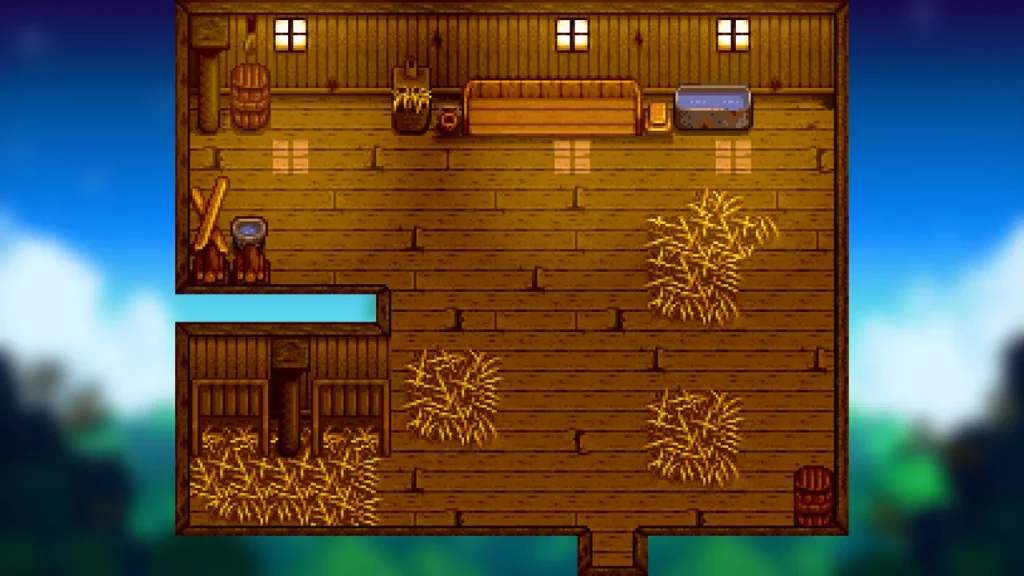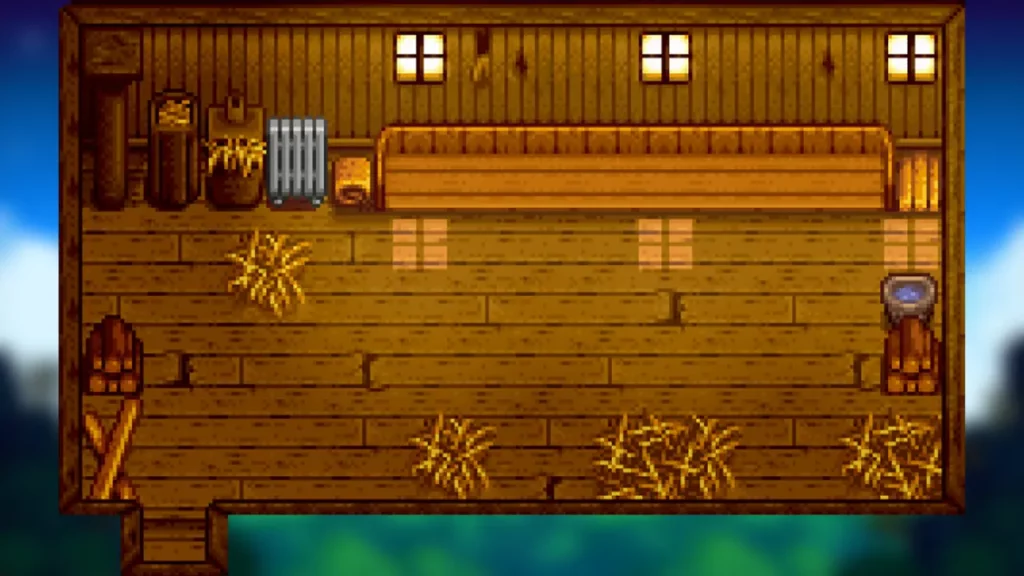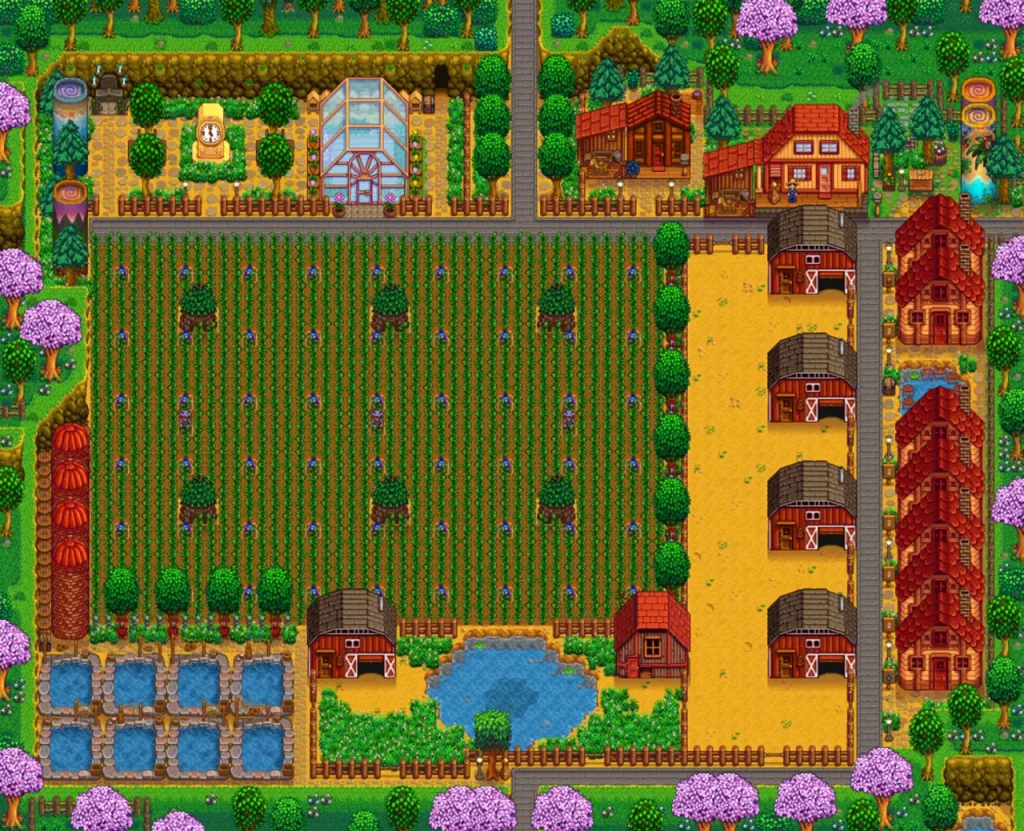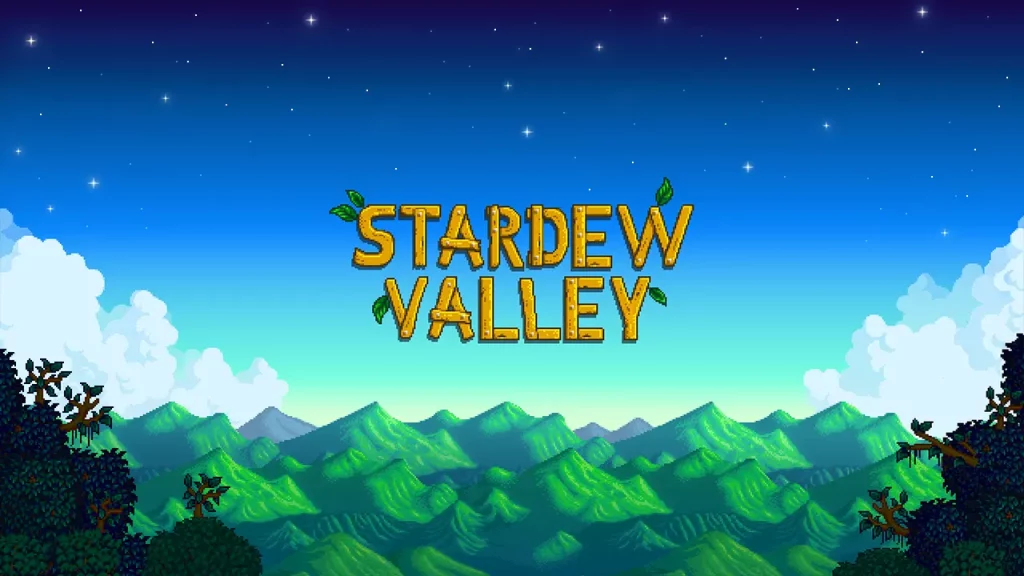As you progress in Stardew Valley, you’ll eventually need to invest in more essential buildings to house your growing farm animals. Two important buildings are the Stardew Valley Barn and Coop. This Stardew Valley Barn or Coop guide will discuss the major differences between barn and coop and their upgrades, designs, and layouts to help you make the best decision for your farm.
Stardew Valley Barn

The Stardew Valley Barn is important for raising animals such as cows, goats, pigs, sheep, and even ostriches. These animals produce valuable resources like milk, wool, and eggs that can be sold or used to create artisan goods. The barn is a substantial investment, but it opens up exciting possibilities for your farm. Let’s look into the specifics of the barn, its sizes, designs, and layout:
Stardew Valley Barn Size
The barn comes in different sizes, ranging from small to deluxe. You need to carefully consider your available space and budget when choosing/upgrading the size. Barns come in three sizes:
- Regular Barn: The initial size costs 6,000g, 350 Wood, and 150 Stone. It holds 4 animals.
- Big Barn: The first upgrade costs 12,000g and requires 550 Wood and 300 Stone. Holds 8 animals.
- Deluxe Barn: This is the final upgrade. It costs 25,000g and requires 1,200 Wood and 600 Stones. It holds 12 animals.
Stardew Valley Barn Design
While the barn’s basic design remains unchanged throughout upgrades, its size and capacity increase, and it features a classic red color scheme, wooden walls, and hay flooring.
You can customize your barn’s appearance by selecting from various designs. Whether you prefer a rustic look or something more modern, the game has a related design available.
Stardew Valley Barn Door
You can access the barn through its primary door, which you can leave open or closed for the animals. The barn door is your entry point.
Animals inside the barn can freely move between its interior and the fenced area outside. Ensure the barn is strategically placed for easy access to your animals (we will discuss detailed layout options later in this article).
Stardew Valley Barn Interior
The barn’s interior houses your animals and features a simple design with hay-covered flooring, wooden walls, and support beams.
Your animals’ living quarters are inside the barn. You need to arrange feeding troughs, beds, and other essentials.
Stardew Valley Barn Setup
Set up your barn with care. Install heaters for winter, and consider placing a milk pail for easy collection. To maximize efficiency, consider putting your barn near your farmhouse, silos, or other animal buildings. This allows for easy access when caring for your animals and gathering resources.
Stardew Valley Barn Decor
You can customize your barn’s appearance with various decorations, such as windows, flooring, and furniture. There are many options to add personal touches to your barn.
You can hang lanterns, place rugs, and more to create a cozy atmosphere for your animals. Remember that animals inside the barn can move or destroy some items, so choose decorations, keeping that in mind.
Stardew Valley Barn Colors
With the 1.5 update, you can now paint your barn using the Paint Bucket, sold at the Carpenter’s Shop or the Furniture Catalogue. Choose barn colors that resonate with your style. You can even match the color of your barn to your farm’s aesthetic.
Stardew Valley Big Barn vs Deluxe Barn
The big barn offers more space for animals. If you’re serious about livestock, this upgrade is worth considering. The deluxe barn is the peak of barn upgrades. It accommodates larger animals and provides ample room for storage.
Stardew Valley Coop
The Stardew Valley Coop is a simpler option, perfect for beginners or those planning to invest more time in eggs and poultry. Coop houses chickens, ducks, rabbits, and dinosaurs. Chickens and ducks provide eggs, while rabbits drop wool and have a chance to produce a Rabbit’s Foot.

Let’s explore the coop’s size, design, and layout:
Stardew Valley Coop Size
The Stardew Valley Coop also comes in three sizes:
- Regular Coop: Costs 4,000g, 300 Wood, and 100 Stone. Holds four animals.
- Big Coop: Costs 10,000g, 400 Wood, and 150 Stone. Holds eight animals.
- Deluxe Coop: Costs 20,000g, 500 Wood, and 200 Stone. Holds 12 animals.
Stardew Valley Coop Design
The coop features a red-and-white color scheme, wooden walls, and hay flooring. Its overall design remains similar to the barn’s but has a smaller footprint.
Stardew Valley Coop Layout
The coop’s layout includes a nesting area for egg collection, a feeding bench for hay, and a central hall area for the animals to roam. As you upgrade, the coop expands to accommodate more animals, and the hay area moves to the back of the structure.
To maximize efficiency, consider placing your coop near other animal buildings, such as the barn or a silo, for easy access to resources. Customize the coop’s appearance with decorations, flooring, or windows, considering that animals may move or destroy some items.
Stardew Valley Barn or Coop
Choosing between a Stardew Valley Barn or Coop depends on your in-game priorities and playstyle. Eventually, you may expand your farm to include both structures, which will provide you with a well-rounded and thriving animal husbandry experience. However, in many cases, starting with a Coop first is a better option for new players to streamline their production management.
Choosing the Stardew Valley Coop as a beginner offers a more accessible and manageable introduction to the animal husbandry aspect of the game, setting you up for success as you progress and eventually expand your farm to include a barn.
Coops cost less to build compared to barns, allowing you to start raising animals without a significant financial investment. Chickens, the primary occupants of coops, require less maintenance and are easier to care for, making them ideal for players new to animal husbandry.
Coops provide access to eggs, which can be turned into mayonnaise, a profitable artisan good. This gives you a steady income source while you learn the ropes of the game. With an incubator in the coop, you can hatch chickens and ducks from eggs, helping you expand your animal population without purchasing new animals.
If you don’t mind putting in extra effort for better rewards, there’s no right or wrong choice between a Stardew Valley Barn and Coop. Still, weighing the pros and cons of each option can help you make an informed decision that best suits your farming goals.
- Coop:
- Cost-effective initial investment: A coop is more affordable to build than a barn, allowing you to get started with animal husbandry sooner.
- Chickens and eggs: Coops enable you to raise chickens, collect eggs, and create mayonnaise, a valuable artisan good.
- Simpler animal care: Chickens require less maintenance, making them suitable for beginners or those seeking a more relaxed farming experience.
- Incubation: You can use an incubator inside the coop to hatch more chickens or ducks from eggs, expanding your animal population.
- Barn:
- Higher initial investment: Barns have a higher upfront cost but offer greater long-term potential regarding product value and animal variety.
- Dairy products and cheese: Barns house cows, goats, and other animals that produce milk, allowing you to create cheese and other dairy products that sell for more than eggs or mayonnaise.
- Larger animals and variety: Barns accommodate larger animals such as cows and goats, diversifying your livestock and allowing you to explore various animal-based resources.
- Hay storage with silo: Investing in a silo to store hay is crucial for both barns and coops, making it a worthwhile purchase regardless of which option you choose.
Consider your preferences and in-game goals to determine which option aligns with your vision for your farm. Opt for the barn if you value dairy products and raising larger animals. If you prefer a simpler approach focusing on eggs and easier animal care, start with the coop.
Coop Basics
The coop houses chickens, ducks, and rabbits. Chickens lay eggs, which you can turn into mayo for profit.
Coop Cost
Coops are more affordable than barns, making them an excellent starting point for new farmers.
Coop Maintenance
Chickens are low-maintenance. Feed them daily, collect eggs, and enjoy the simplicity.
Coop Upgrades
Consider upgrading your coop to accommodate more animals or add an incubator for hatching eggs.
Stardew Valley Barn and Coop Layout
In Stardew Valley, the layout of your Barn and Coop can greatly impact your farm’s productivity and overall aesthetics. Consider the following two popular layout approaches based on your priorities:
Maximizing Production Layout

This layout focuses on optimizing the output of animal products, making it perfect for players aiming to optimize their resources. Follow these steps to create a production-focused layout:
- Fill your Barn or Coop with as many machines as possible to process animal products efficiently.
- Include just enough hay feeders to keep your animals content and productive.
- Install auto-grabbers to collect the produced goods automatically, eliminating the need to enter the coop or barn daily.
- Prioritize animals that produce items processable by machines, such as cows (milk for cheese) and pigs (truffles for oil).
Aesthetics-Focused Layout

Consider an aesthetics-focused layout to create a visually appealing and charming space for your animals. Here’s how to achieve this:
- Incorporate decorative items like crafted furniture, grass patches, or lighting elements to enhance the coop or barn’s appearance.
- Instead of relying solely on feeders, scatter hay around the floor for a more natural look.
- Experiment with various design elements and layouts to create a unique, personalized space that complements your farm’s look and feel.
To create an efficient setup, place your barn near other essential farm buildings, like your farmhouse, silos, or other animal buildings, ensuring easy access to resources and daily tasks.
Plan your farm layout carefully. Coordinating the barn’s location with other structures ensures efficiency and aesthetics. As you upgrade the barn, additional space becomes available, and the hay area moves to the back of the structure.
Place your coop near other animal buildings or resources like the barn or a silo for efficient farm management. Chickens and ducks lay eggs, while rabbits drop wool and have a chance to produce a Rabbit’s Foot.
The Stardew Valley Barn and Coop layout play vital roles in your farming journey, enabling you to raise various animals and collect valuable resources. Considering their sizes, layouts, and customization options, you can create a well-rounded, thriving farm that caters to your needs and preferences.
That’s everything for this Stardew Valley Barn or Coop guide. If you find this guide helpful, consider checking out our other topics, like the 10 best farm layouts and the best mods for Stardew Valley.


